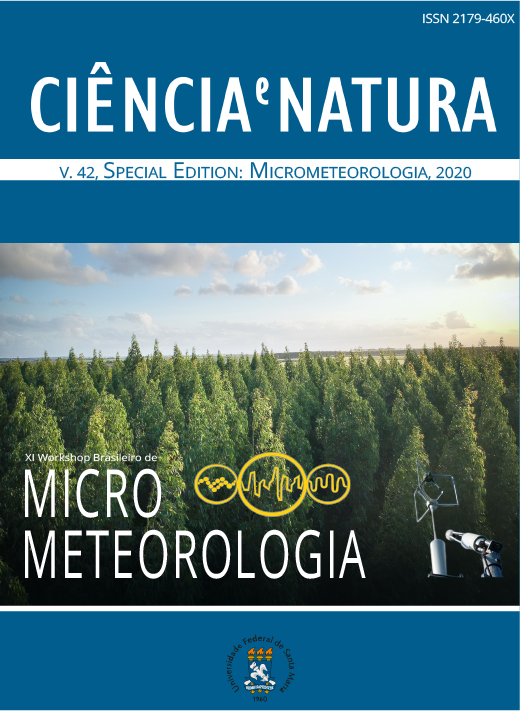O escoamento atmosférico no Centro de Lançamento de Alcântara
DOI:
https://doi.org/10.5902/2179460X53217Palavras-chave:
Escoamento ao redor de um obstáculo, Dinâmica dos Fluidos Computacional (CFD), Turbulência atmosférica, Lançamento de foguetesResumo
O escoamento atmosférico no Centro de Lançamento de Alcântara (CLA) foi estudado utilizando técnicas de Dinâmica dos Fluidos Computacional (CFD). Para caracterizar a região foi considerada a presença da falésia e da Torre Móvel de Integração (TMI), ambas dentro do Setor de Preparação e Lançamento (SPL). Nesse estudo, a falésia de 40 metros de altura foi representada por um degrau de 90°. O perfil de velocidade de entrada foi elaborado de acordo com a lei de potência, com expoente de 0,11, velocidade média de 20 m/s e número de Reynolds de 4,3 x 105, considerando a atmosfera com estabilidade neutra. Três direções de vento foram testadas, 90º, 125º e 135°. O modelo numérico utilizado foi o Reynolds Stress Model (RSM), baseado nas equações de Reynolds-Averaged Navier-Stokes (RANS). A solução das equações foi obtida pelo software ANSYS FLUENT 19, que utiliza o método dos volumes finitos. Os resultados apresentaram boa concordância com os experimentos de túnel de vento especialmente para direção do vento perpendicular à falésia. A direção predominante do vento influencia fortemente a dinâmica do escoamento atmosférico no SPL, formando um vórtice helicoidal sobre a falésia associado à rotação do vento.
Downloads
Referências
ARYA, P. S. Introduction to micrometeorology. [S.l.]: Elsevier, 1999. v. 79.
FARIA, A. F.; AVELAR, A. C.; FISCH, G. Wind Tunnel Investigation of the Wind Patterns in the Launching Pad Area of the Brazilian Alcântara Launch Center. Journal of Aerospace Technology and Management, v. 11, 2019.
HSU, S.; MEINDL, E. A.; GILHOUSEN, D. B. Determining the power-law wind-profile exponent under near-neutral stability conditions at sea. Journal of Applied Meteorology, v. 33, n. 6, p. 757-765, 1994.
LUO, W.; DONG, Z.; QIAN, G.; LU, J. Wind tunnel simulation of the three-dimensional airflow patterns behind cuboid obstacles at different angles of wind incidence, and their significance for the formation of sand shadows. Geomorphology, v. 139, p. 258-270, 2012.
PATANKAR, S. Numerical heat transfer and fluid flow. CRC press, 1980.
PIRES, L. B. M.; ROBALLO, S. T.; FISCH, G.; AVELAR, A. C.; GIRARDI, R. M.; GIELOW, R. Atmospheric flow measurements using the PIV and HWA techniques. Journal of Aerospace Technology and Management, v. 2, n. 2, p. 127-136, 2010.
PIRES, L. B. M..; SOUZA, L. F.; FISCH, G.; GIELOW, R. Numerical study of the atmospheric flow over a coastal cliff. International Journal for Numerical Methods in Fluids, v. 67, n. 5, p. 599-608, 2011.
ROBALLO, S. T.; FISCH, G.; GIRARDI, R. d. M. Escoamento Atmosférico no Centro de Lançamento de Alcântara (CLA): PARTE II – Ensaios no Túnel de Vento. Revista Brasileira de Meteorologia, v. 24, n. 01, 2009.
SAEEDI, M.; LEPOUDRE, P. P.; WANG, B. C. Direct numerical simulation of turbulent wake behind a surface-mounted square cylinder. Journal of Fluids and Structures, v. 51, p. 20-39, 2014.
SOUZA, B. H. de; FISCH, G. F.; GOULART, E. V. Simulação do escoamento atmosférico no Centro de Lançamento de Alcântara (CLA) utilizando a técnica de CFD. In: WORKSHOP BRASILEIRO DE MICROMETEOROLOGIA, 9., 2015, Santa Maria - RS. Annals... Santa Maria - RS: UFSM, 2015.
Downloads
Publicado
Como Citar
Edição
Seção
Licença
Para acessar a DECLARAÇÃO DE ORIGINALIDADE E EXCLUSIVIDADE E CESSÃO DE DIREITOS AUTORAIS clique aqui.
Diretrizes Éticas para Publicação de Revistas
A revista Ciência e Natura está empenhada em garantir a ética na publicação e na qualidade dos artigos.
A conformidade com padrões de comportamento ético é, portanto, esperada de todas as partes envolvidas: Autores, Editores e Revisores.
Em particular,
Autores: Os Autores devem apresentar uma discussão objetiva sobre a importância do trabalho de pesquisa, bem como detalhes e referências suficientes para permitir que outros reproduzam as experiências. Declarações fraudulentas ou intencionalmente incorretas constituem comportamento antiético e são inaceitáveis. Artigos de Revisão também devem ser objetivos, abrangentes e relatos precisos do estado da arte. Os Autores devem assegurar que seu trabalho é uma obra totalmente original, e se o trabalho e / ou palavras de outros têm sido utilizadas, isso tem sido devidamente reconhecido. O plágio em todas as suas formas constitui um comportamento publicitário não ético e é inaceitável. Submeter o mesmo manuscrito a mais de um jornal simultaneamente constitui um comportamento publicitário não ético e é inaceitável. Os Autores não devem submeter artigos que descrevam essencialmente a mesma pesquisa a mais de uma revista. O Autor correspondente deve garantir que haja um consenso total de todos os Co-autores na aprovação da versão final do artigo e sua submissão para publicação.
Editores: Os Editores devem avaliar manuscritos exclusivamente com base no seu mérito acadêmico. Um Editor não deve usar informações não publicadas na própria pesquisa do Editor sem o consentimento expresso por escrito do Autor. Os Editores devem tomar medidas de resposta razoável quando tiverem sido apresentadas queixas éticas relativas a um manuscrito submetido ou publicado.
Revisores: Todos os manuscritos recebidos para revisão devem ser tratados como documentos confidenciais. As informações ou ideias privilegiadas obtidas através da análise por pares devem ser mantidas confidenciais e não utilizadas para vantagens pessoais. As revisões devem ser conduzidas objetivamente e as observações devem ser formuladas claramente com argumentos de apoio, de modo que os Autores possam usá-los para melhorar o artigo. Qualquer Revisor selecionado que se sinta desqualificado para rever a pesquisa relatada em um manuscrito ou sabe que sua rápida revisão será impossível deve notificar o Editor e desculpar-se do processo de revisão. Os Revisores não devem considerar manuscritos nos quais tenham conflitos de interesse resultantes de relacionamentos ou conexões competitivas, colaborativas ou outras conexões com qualquer dos autores, empresas ou instituições conectadas aos documentos.






